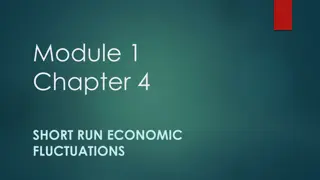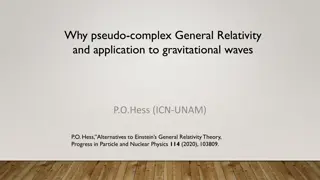Exploring Pseudo-Goodwin Cycles in a Minsky Model
This paper delves into the dynamics of Pseudo-Goodwin cycles within a Minsky model, examining the counter-clockwise movement of output and wage share. It distinguishes between true Goodwin cycles and pseudo variants, highlighting the role of income distribution, debt, and demand in shaping economic cycles.
Uploaded on Sep 08, 2024 | 0 Views
Download Presentation

Please find below an Image/Link to download the presentation.
The content on the website is provided AS IS for your information and personal use only. It may not be sold, licensed, or shared on other websites without obtaining consent from the author. Download presentation by click this link. If you encounter any issues during the download, it is possible that the publisher has removed the file from their server.
E N D
Presentation Transcript
Pseudo-Goodwin cycles in a Minsky model E Stockhammer & J Michell
Main idea Goodwin cycle: profit-led demand + reserve army effect => counter- clockwise movement of output and wage share This paper: the existence of a counter clockwise movement of output and the wage share is not a sufficient condition for the existence of Goodwin cycle Pseudo-Goodwin cycle: a counter-clockwise movement of output and wage share without a Goodwin mechanism = something that looks like a Goodwin cycle, but isn t simple Minsky-type model. We add a distribution adjustment a la Goodwin. In this model the cycle is generated from the interaction of debt (financial fragility) and demand. Income distribution preys on demand, but it has not feedback. By design, demand does not react to changes in income distribution. However, the model does exhibit a pseudo Goodwin cycle in the output-wage share space.
Outline 1. Why it matters 2. Goodwin cycle (model) 3. A simple Minsky model (M1) 4. A Minsky model with a reserve army effect (M2) 5. Extending the model for small wage-led demand effect (M3) 6. Conclusion
Taylor (2012) Paper on heterodox theories of business cycles Distribution and demand cycles Contrasts Goodwin cycle ( Domar-style investment and profit squeeze ) and Kalecki cycle ( Harrod investment and wage-led demand ? = ? ? , ? = ? ? Goodwin/Domar: ? < 0, ? > 0 Kalecki/Harrod: ? > 0, ? < 0 Observes that data indicate that cycle turns the Goodwin way => Overall, Domar-style investment and a profit squeeze appear to fit the data better than Harrod investment and short-run wage- led aggregate demand. (p. 50) Finance and demand cycles But no discussion of what [w,y]cycles these will give rise to
Profit squeeze cycles vs wage-led cycles Taylor (2012) calls these investment a la Domar(profit squeeze cycles vs investment a la Harrod (wage-led cycles Diallo et al (2011) use profit and labour market led vs wage and good market led cycles
Pseudo-Goodwin cycle Pseudo Goodwin cycle: it looks like a Goodwin cycle, but it isn t Goodwin cycle: profit-led demand and Marxian distribution function -> counter- clockwise cycle in wage share-output space Pseudo Goodwin cycle: counter-clockwise cycle in wage share-output space that is not due to Goodwin mechanism, In particular: not related to profit-led demand
Goodwin model demand + - Distribution Finance Wage share
Goodwin cycle Goodwin cycle in predator prey version ? = ?(1 ?) ? = ?( ? + ??) ? income, ? wage share two stationary points, at ? = 0,? = 0 and ? =? ? ? = 1, . Plot: ? peaks before ?
Empirical literature on Goodwin cycles (and profit/wage-led demand) Methodological approach Identifying cycle: which direction does it turn? In which order Identify behavioural equation for investment and consumption Marxist debate: profit squeeze theory vs. underconsumptionists Sherman (1997), van Lear (1999), Goldstein (1999), Harvie (2000) Marxists Post Keynesians/Kaleckians : profit led demand vs. wage-led demand Diallo et al (2011), Taylor (2012) Barbosa-Filho & Taylor (2006), Proano et al (2011) Bowles & Boyer (1995), Stockhammer & Onaran (2004), Naastepad & Stoorm (2006), Hein & Vogel (2008), Stockhammer & Stehrer (2011)
Goodwin and PK Economics Heterodox economists agree that distribution matters for demand. But they disagree on the sign of the effect Goodwin / Marx: profit share investment demand ( profit-led demand ) Goodwin cycle: profit share investment growth employment profit share investment Kalecki / Post Keynesians: profit share consumption demand ( wage- led demand ) Kaleckian cycle: profit share consumption demand investment growth employment : profit share Agreement: dC/dWS > 0 and dI/dWS < 0 Goodwin: effect of wage share on investment is direct growth increases. Kalecki: effect of wage share on consumption is larger than effect on investment profit rate falls growth falls. PKs posit wage-led demand, but don t derive business cycle theory from that rather BC results from finance-demand interaction (Minsky) or demand-capacity interactions (Kalecki) 11
Minsky model Minsky gives narrative discussion of cycle mechanism -> a substantial lit trying to model Minsky cycles Minsky suggests endogenous cycle in fragility and output: Higher output leads to higher fragility (endogenous shift to more fragile financial structure as expansions are debt financed) Higher fragility leads to lower output Charles (2008), Fazzari et al (2008) and Asada (2001) relevant models. They differ substantially in the details of the model Charles (2008) debt higher interest Fazzari et al (2008) growth inflation higher interest Asada (2001): unstable (Kaldorian) goods market Lavoie and Seccareccia (2001) argue that debt need not increase during the boom not our concern here. Our stylized Minsky model does not go into detail, but in principle consistent with these Minsky cycle models
Model Minsky (M1) demand - + Finance financial fragility distribution
Minsky cycle (M1) ? = ?( 1 + ??) ? = ?(1 ?) ? : financial fragility, ? : output Non-trivial equilibrium ? 1 ? = 1/? 0 ? 0= 0 + 0 At equilibrium ? = 1/? The cycle will be such that y peaks before f.
M2: Minsky model with reserve army demand - + + Finance Distribution Financial fragility Wage share
Minsky model with reserve army effect (M2) We want to discuss a model ? = ?( 1 + ??) ? = ?(1 ?) ? = ?( ? + ?? ?) ? feeds on ?. But it generates no feedback onto ? or ?. We add a feedback of w on ? to ensure stability
Role of wage share Model closely related to predator-prey model with scavenger in biology (Chauvet et al 2002, Nolting et al 2008) More accurately: real wage is a harmless parasite. It feeds on higher output but causes no harm Real wage is also has self-regulating element Model thus different from Keen (1995) -- he models economies with Minsky as well as Goodwin cycles.
M3: Minsky model with reserve army effect and wage-led demand effect demand - + + + finance distribution
Model M3: Pseudo-Goodin model with wage-led demand effect Minsky cycle with reserve army effect and wage-led demand equation. ? = ?( 1 + ??) ? = ?(1 ? + ??) ? = ? ? + ?? ?
Summary The existence of a counter-clockwise movement in output-wage share space is not proof of the existence of a Goodwin cycle. Pseudo-Goodwin cycles: look like Goodwin cycle, but are not generated by Goodwin mechanism. A Minsky model with reserve army effect (M2), but without profit-led demand can give rise to pseudo-Goodwin cycles. A Minsky model with reserve army effect and wage-led demand (M3) can also generate (unstable) pseudo-Goodwin cycles.
Conclusion Taylor (2012), Diallo et al (2011) interpret counter- clockwise movement of in output-wage share space as evidence for Goodwin cycles and, by implication, for a profit-led demand regime. This is incorrect. Pseudo-Goodwin cycles can arise independent of profit-led demand; and they can also arise in wage-led demand regime. Extension: A wide range of business cycle models will give pseudo Goodwin cycle if there is a reserve army distribution function Positively put, for the type of models we have analysed: counter-clockwise movement of in output-wage share space is evidence for a reserve army-type distribution function, but not for profit-led demand.
Appendix We have assumed that wage share eqn contains self-stabilising mechanism If relax this assumption this, we get modified results: If wage-share eqn is linear combination of fragility equation, closed orbits in all pairs of variables. If not linear combination, no closed orbits, but instead explosive or implosive oscillations in w. But still a (decaying) pseudo-Goodwin cycle.
Empirical lit Goldstein (1999) estimates a two equation VAR with unemployment and the profit share, but the results cannot be interpreted as demand functions. Harvie (2000) follows Goodwin in assuming that all profits get automatically reinvested. Consequently there is no demand side to be estimated, but only various components of the distribution side. Mohun and Veneziani s (2007) contribution lies in the careful discussion of the definition of profits and wages. They aim to identify the cycle and its forces by providing a discussion of plots of HP- filtered data, but no econometric analysis of the relevant behavioral equations is undertaken. Barbosa-Filho and Taylor (2006) estimate a two equation VAR with a demand equation and a distribution equation (without contemporaneous interaction) for the US economy using quarterly data and the cyclical component of the HP filter. The effects for individual components of demand are then decomposed from the aggregate results (rather than estimated as behavioral equations). This gives strong perverse results in the consumption function. The (negative) effect of an increase in the wage share on consumption is larger than those on investment and net exports combined. They conclude that the US economy is in a profit-led demand regime. Stockhammer and Stehrer (2011) note that the results based on the HP filed are suffering from serious autcorrelation problems and the results are not robust with respect to the lag length. Contrast to Kaleckian wage-led lit Stockhammer & Stehrer argue that the existing Goodwin lit has paid insufficient attention to the demand side. In particular it has failed to present convincing evidence that profits react substantially to profits.























